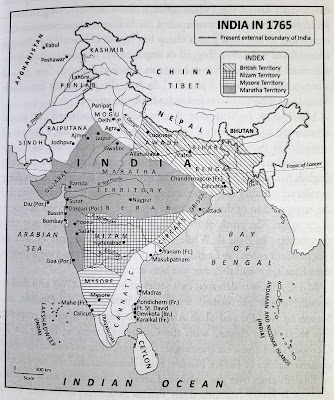-> When
Mughal Empire began to decay, the strongest power remained was Maratha. It
alone possessed the strength to fill the political vacuum created by the
disintegration of the Mughal Empire.
-> Maratha
produced a number of brilliant commanders and statesmen, who can secure and
handle the empire. There was no doubt on Maratha sardars and soldier’s Bravery
and honesty but what they lacked was unity, outlook and programme necessary
for founding all-India empire. So, they failed to replace the Mughals and
continued war until the Mughal Empire got destroyed.
-> The grandson of chhatrapati Shivaji, Shahu had been a
prisoner of Aurangzeb since 1689. In fact,
Aurangzeb treated him and his mother with dignity, honour and consideration,
paying full attention to their religious, caste and other needs, hoping perhaps
to arrive at a political agreement with Shahu.
-> Shahu
was released in 1707, after the death of
Aurangzeb. Soon, a civil war broke out between shahu and his aunt for power,
his aunt Tara Bai at Kolhapur had carried out an anti-mughal struggle since 1700 in the name of her son Shivaji-II, after the
death of her husband Raja Ram.
-> The
conflicts between Shahu and his rival at Kolhapur developed a new system of
Maratha Government under the leadership of Balaji
Vishwanath, The Peshwa of King Shahu. The Peshwa means chief minister.
The period of this peshwa domination transformed Maratha state into empire.
.jpeg) |
| Balaji Vishwanath |
-> Balaji
Vishwanath was a Brahmin and started his life as a petty revenue official and
then rose step by step. He rendered shahu loyal and useful service in
suppressing his enemies. He was great diplomate and won over many of the big
Maratha sardars to shahu’s cause. In 1713, He
was prompted to the Peshwa of King Shahu. Balaji
soon consolidated shahu’s hold and his own over the Maratha sardars and most of
the Maharashtra except for the region south of Kolhapur. The Peshwa
concentrated power in his office and eclipsed the other ministers.
-> Balaji
took full advantage of the internal conflicts of the Mughal officials to
increase Maratha power. He had induced Zulfiqar khan (Mughal official) to grant
the Chauth and sardeshmukhi of the Deccan. Later he signed a pact with Saiyid
brothers, All the terretories that had earlier formed shivaji’s kingdom were
restored to Shahu, who was also assigned the Chauth and sardeshmukhi of the six
provinces of the Deccan. In return Shahu had agreed to provide 15,000 cavalry
at the emperor’s service, to prevent rebellion and plundering in the Deccan and
to pay 10 lakh Rs annually.
-> In 1719, Balaji Vishwanath, at the head of Maratha force,
accompanied Saiyid Hussain Ali Khan to Delhi and helps Saiyid brothers in
overthrowing Farrukh Siyar. As Balaji and other Maratha sardars understood the
weakness of the Empire, the ambition of expanding in north has grown.
-> Balaji
assigned the separate area to different Maratha sardars to collect Chauth an
sardeshmukhi which increased personal power of Peshwas. It created more number
of ambitious sardars which in turn started increasing their area by conquering
the area of Mughal empire. Thus, the conquest of Maratha outside their original
kingdom were not made by a central army directly controlled by the Maratha king
or the Peshwa.
-> Balaji Vishwanath died in 1720. He was succeeded as
Peshwa by his 20 year old son, Baji Rao-I. He
was a bold and brilliant commander and an ambitious and clever statesman. He
has been described as “the greatest exponent of
guerrilla tactics after Shivaji”.
 |
| Baji Rao - I |
-> Maratha
waged numerous campaigns against the Mughal, trying to compel Mughal officials
first, give them the right to collect Chauth of vast area, second, to cede
these area to the Maratha kingdom.
-> All his tenure Baji Rao worked to contain Nizam-ul-Mulk’s power in Deccan. Twice he fought on the
field and both time Nizam was worsted and compelled to grant the Marathas the Chauth and sardeshmukhi
of Deccan province.
-> In
1733, Baji Rao started a long campaign against the Sidis of Janjira and
expelled them from mainland.
-> By
1740, the Marathas had won control over Malwa, Gujrat,
and some parts of Bundelkhand.
-> In 1740, Baji Rao died. In short period of 20 years, he
had changed the character of the Maratha state. From the
kingdom of Maratha it had been transformed into an empire.
 |
| Maratha Empire |
-> Son of
Baji Rao was Nana Saheb (Balaji Baji Rao), who
succeeded his father. King Shahu died in 1749
and by his will, administration was left in hands of Peshwa. Peshwa was the de
facto ruler of the state. Peshwa became the official head of administration and
shifted the government to Poona at his headquarters.
-> Nana
Saheb followed in the footsteps of his father and further extended the empire
in different directions, taking Maratha power to new heights.
-> In
1752, the Nawab of Bengal had to cede Orissa and in south, the state of Mysore
and other minor state were forced to pay tribute.
-> in
1760, the Nizam of Hyderabad was defeated at Udgir and compelled to cede vast
territories yielding an annual income of Rs 62 lakh.
-> In the
north, the Maratha soon became the power behind Mughal throne. Maratha also
controlled Rajputana and Gangetic Doab and in 1752, they reached Delhi and
helped Imad-ul-Mulk to become Wazir, who became puppet in their hands.
-> In this post we have discussed the rise of Maratha empire, Soon, we will be having post on decay of Maratha empire. You can observe the area of Maratha empire got reduced between 1759 to 1765.
 |
| Maratha Territory in 1765 |

.jpeg)

6 Comments
👍👍
ReplyDelete👏👏
ReplyDelete👏👏
ReplyDeleteMast
ReplyDelete⛳
ReplyDeleteFantabulous 🤩
ReplyDeletePost a Comment